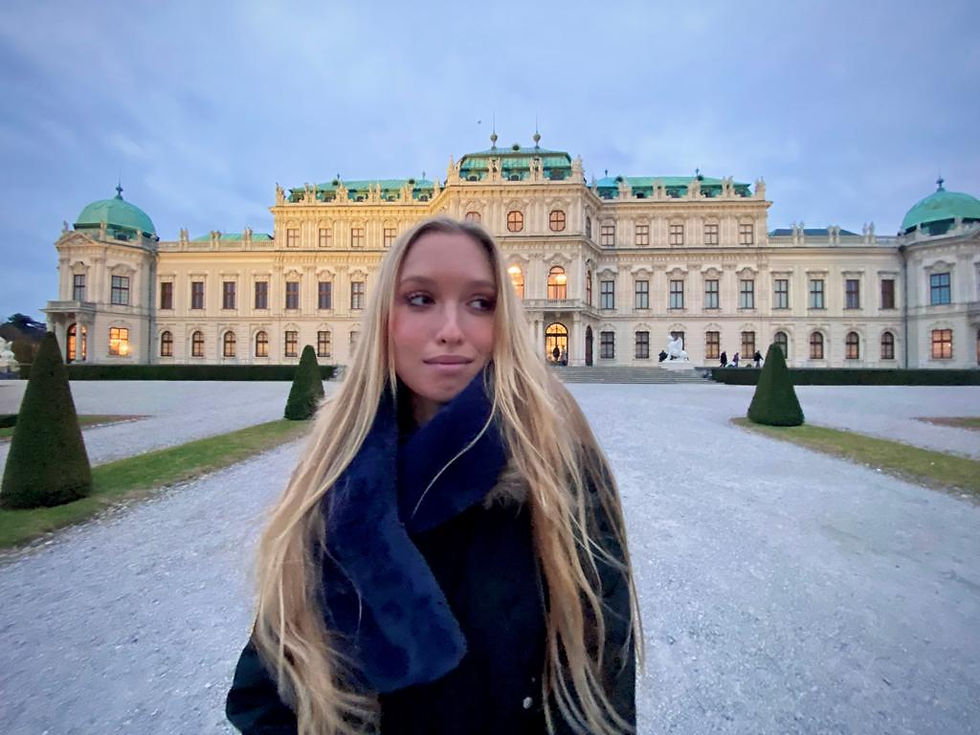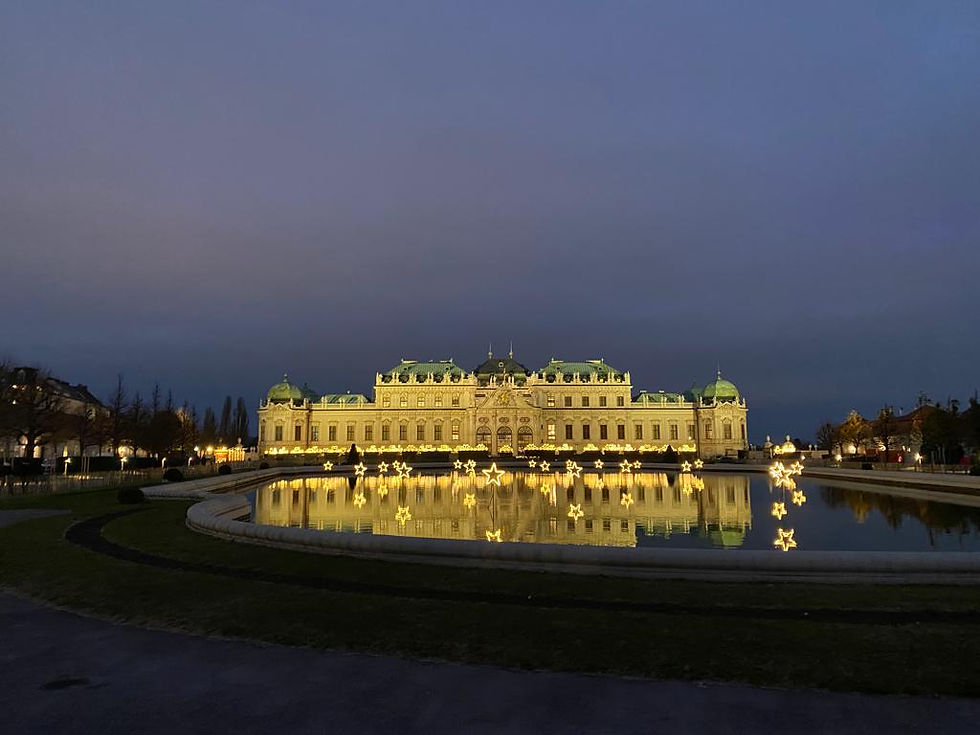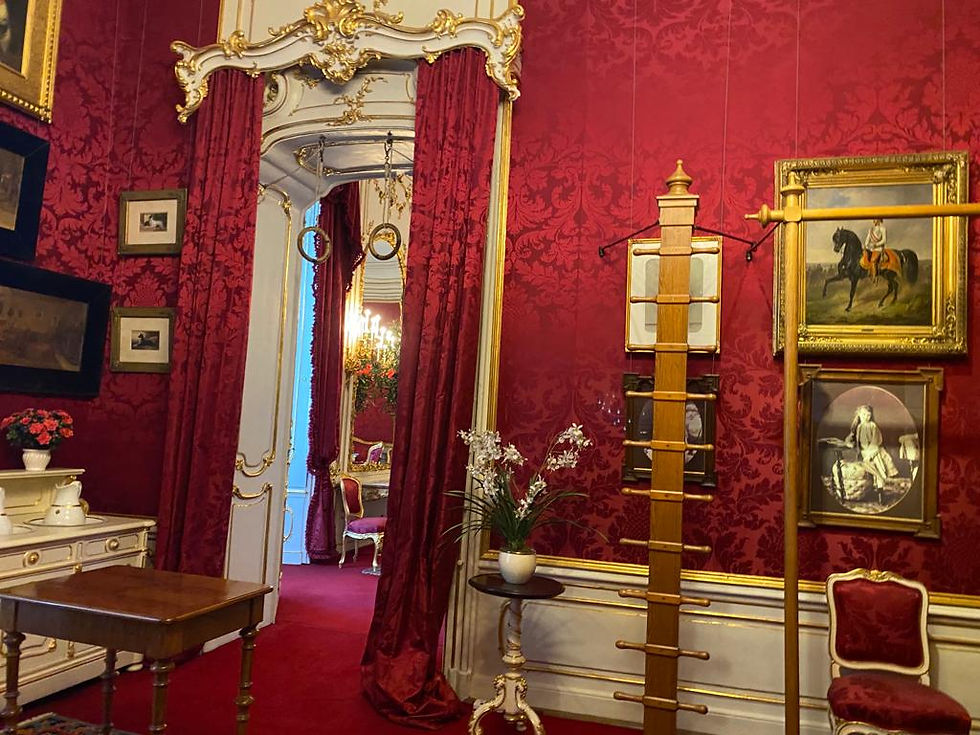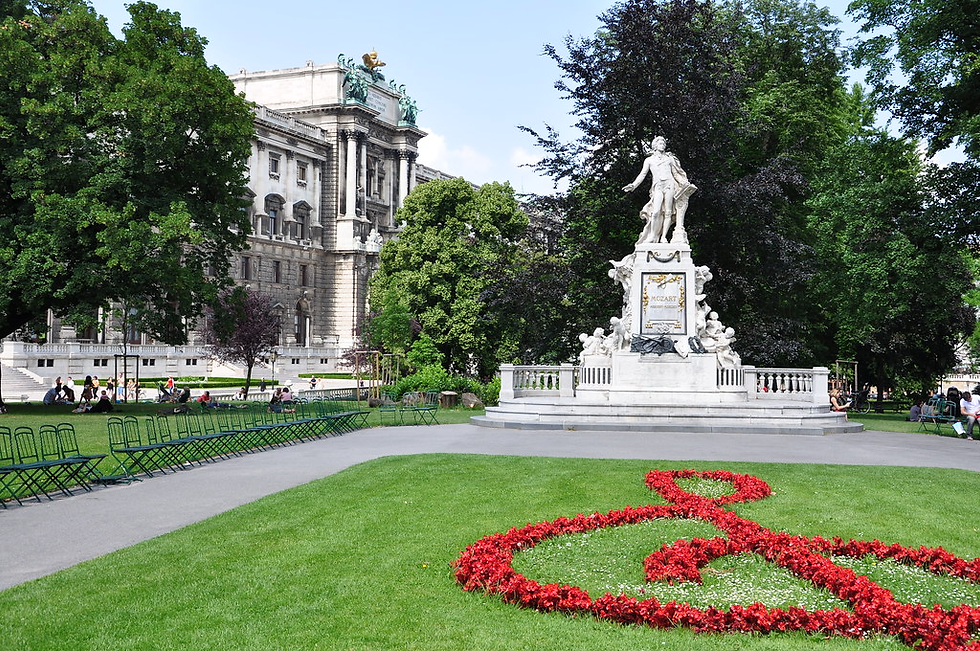Austria- Vienna, Wachau, Graz, Slazburg, Hallstatt, Innsbruck
- devildetailspt
- Nov 6, 2022
- 9 min read
Table of Contents:
Vienna
Vienna
An Imperial city of Habsburg legacy with marvelous sites to see, whether it is sunny or snowing, Vienna waits for you!
Known as the "City of Music" due to its musical legacy, as many famous classical musicians such as Beethoven and Mozart called Vienna home.
Vienna is also said to be the "City of Dreams" because it was home to the world's first psychoanalyst, Sigmund Freud.
The city retains the feel of a large town, despite its size. Part of that is down to the numerous parks, woodlands, and other open and green spaces, but it is perfectly enough in two days to see most of Vienna. If you want to catch an opera, a ballet, visit museums and see more palaces you will need more days. This is why the first thing you need to think of are which palaces you will visit. My personal favorite is the Belvedere, full of history, beautiful outside and Klimt filled beautiful on the inside too. My second choice is the Hoffburg (Sissi's Palace) and you can still fit in a third choice- Schoenbrunn.
Tips: If you go during covid the FFP2 masks are mandatory and the only ones that will do.
Search which pass works best for for the museums and the Vienna Pass.
The metro is great I used it everywhere.
If you go during winter don't be upset that the fountains won't have an water (so the ice wont shatter them)
Platz= piazza/square
Strauss= street
The itinerary is divided into two very busy days you might want to split if you don't want to rush.
Day 1
Started early at Schoenbrunn Palace. The Habsburgs' opulent summer palace and a Unesco World Heritage site. There are free audio guides provided, and it is recommended that you buy tickets online (€14) before, although I went in November 2020, so it was empty.






Belvedere Palace - The Baroque palace complex was built as a summer residence, inspired by Versailles, for Prince Eugene of Savoy. The Palace, divided in two, Upper and Lower Belveder contains an imperial collection of paintings such as Klimts The Kiss and Lady with the Fan. Klimt's Woman in Gold, as you may remember from the movie, was reclaimed from the museum because it had been stolen by Nazis and is now on display in a New York Gallery. On 15 May 1955, the State Treaty for the Re-establishment of an Independent and Democratic Austria is signed at Belvedere Palace in Vienna. Entry is €15.





The above is a personal favorite of man by Osman Hamdi Bey.


Karlskirche church- a Baroque Church in Karlsplatz constructed in 1737 dedicated to St Charles Borromeo. The composer Antonio Vivaldi died in Vienna and was buried there on July 28, 1741 but his tomb has been lost over time. The church hosts regular Vivaldi concerts in his honour. The church is even more beautiful in warmer seasons, for there is a small lake in front which mirrors the church. Unfortunately, since I went in November, the water was gone so that it wouldn't turn to ice and destroy its container.

Vienna State Opera/ Weiner Staatsoper- built in the 19th Century inaugurated for Emperor Franz Joseph and Sissi.

Sacher Hotel. During your trip you must trip the Sachertarte, made out of Chocolatesponge cake, apricot jam, dark chocolate icing, so what better place then the Sacher Hotel, the five star luxury hotel famous for it's sachertorte created by Franz Sacher who's son then built the hotel. Many luminaries have graced these rooms, including Queen Elizabeth II, J.F.K., Graham Greene and John Lennon, the noir '39 film The Third Man was filmed here too.

or
-Cafe Central (both tend to be very busy, book in advance)

St Stephens Cathedral in Stephenplatz (you can climb and see the landscape from the highest point of the city 3,50euros). Its is a Gothic masterpiece also worth a look inside.
If you visit during christmas season there is a christmas market there and wonderful christmas lights too such as the stairway to heaven below.



Before heading to Graben street it is worth taking a detour to the Ankeruhr (Anchor clock). A plaque next to the clock reveals the identities of these rotating figures, who represent a journey through Austrian history.


Stroll the Graben street the most famous shopping street in Vienna.

The Plague column in Graben Street

St Peters Catholic Church

The brand Swarovski is Austrian founded in 1895.


Ferstel Passage- A historic arcade with high end hopping you can cross from one side to the other.

Day 2
Hofburg Palace, home base of the Habsburgs from 1273 to 1918. Since 1946 it is the official residence and workplace of the president of Austria. Home of the most beloved empress Sissi (Elizabeth), you can visit (16euros) her rooms and even see her exercise room which women were not supposed to have at the time.The palace faces the Heldenplatz (Heroes Square).




The Library is very impressive:

The Spanish Riding School. The world-famous performances by the Lipizzans – the Ballet of the White Stallions (named for the Spanish horses that formed one of the bases of the Lipizzan breed, which is used exclusively at the school, nowadays they are bred in Austria).

The Volksgarten - a large park part of the Hofburg from the 19th Century.
In warm weather see the roses, the park is famous for it's rose gardens. At the northern end of the park stands the Empress Elizabeth Monument, a statue of the Empress seated sculpted from marble. The Volksgarten contains two fountains, the Triton and Nymph Fountain and People's Garten Fountain.

Buggarten next to the Hofburg is another garden with a Mozart Monument.

Albertina Museum. In March 1945, the Albertina was heavily damaged by Allied bomb attacks. The building was rebuilt in the years after the war and was completely refurbished and modernized from 1998 to 2003. In 2020 a new section opened the 'Albertina Modern'. The Baroque palace of Albertina was built in 1744 and gifted in 1794 to the Duke Albert of Saxe-Teschen, hence its name.

Maria-Theresien-Platz in honor on Maria Therese (ruler of the Habsburg for a 40 year span), joins the Ringstraße with the Musuemsquartier, facing each other from the sides of the square are two near identical buildings, the Naturhistorisches Museum (Natural History Museum) and the Kunsthistorisches Museum (Art History Museum).The buildings are near identical, except for the statuary on their façades. The Naturhistorisches' façade has statues depicting personifications of Africa, Asia, Europe, and the Americas. The Kunsthistorisches façade features famous European artists, such as the Dutch Bruegel, among others.

-Kunsthistorisches Museum -knows as 'Museum of Fine Arts' is the largest art museum in the country and one of the most important museums worldwide.. Housed in its festive palatial building on Ringstraße. On the stairwell's roof are frescoes by Klimt.
Emperor Franz Joseph I of Austria-Hungary opened the facility around 1891 at the same time as the Natural History Museum, Vienna which has a similar design and is directly across Maria-Theresien-Platz. The two buildings were constructed between 1871 and 1891

-Natural History museum. It has a large collection of butterflies.

Museumsquartier. The Leopold Museum, housed in the Museumsquartier is home to one of the largest collections of modern Austrian art, featuring artists such as Egon Schiele, Gustav Klimt, Oskar Kokoschka and Richard Gerstl.

Rathaus, the Vienna City Hall, seat of local government of Vienna, located on Rathausplatz. Fun fact: For a brief period between 1892-1894, the Vienna City Hall was the world's tallest building, until it was eclipsed by Milwaukee City Hall. If you go during Christmas there is a Christmas maket there like in the photos I took below:





The next three places are far off so take the metro or Uber.
Stadtpark - The gildedbronzemonument of Johann Strauß II, is one of the most known and most frequently photographed monuments in Vienna. He played manhy concerts here.
Next to the entrance of Stadtpark in the Intercontinental, if you can go inside to have a look at the bar where there is an incredible chandelier!

-Hundertwasserhaus (unique colorful house by Hundertwasserhaus)



-Prater/Wurstelprater- An amusement park that dates back to the time of the Austrian Empire, when Emperor Joseph II made the Prater (which had been serving as Imperial hunting ground until then) open to the public in 1766. There is no entry fee, only fees for each ride. The most famous ride is the Ferris Wheel. It tends to be very empty in winter although there is a christmas market there too.

Typical food:
*Sacher Torte
*Appel Strudel
*Schnitzel
I would recommend the restaurant Reinthaler's Beisl near Stephenplatz, looked very traditional and busy, with good schnitzel and strudel.


Graz
One of the most important and industrial cities of Austria, Graz is the capital of the region Styria and has a worth visitng old city center and the River Mur. It is two hours away from Vienna, you can go by flix bus, car or train.
From the Old Town you can easily reach the Clock Tower in about 15 minutes. You have two options: Either you take the stairs from the Felsensteig (260 steps), which starts on the Schlossbergplatz. Or, you can stroll through the several hiking trails in the park. For those who’d rather skip the exercise, there is the Schlossbergbahn (a funicular) or the glass Schlossberglift, which runs through the middle of the mountain-has worlds tallest indoor slide.
Felsentsteig:

Old Town:

Grazer burg with double spiral staircase (Doppelwendeltreppe.)

Kunsthaus Graz (Art Museum) also known by the alien because of how strange it looks (you can also see it from the schlossberg view point), but i found it an interesting idea very creative.
The Murinsel in Graz is a floating platform in the Mur that was created as part of the Capital of Culture year. In addition to the historic Schloßberg, they wanted to create a new, modern landmark for the city. This landmark of Graz was designed by New York City artist Vito Acconci on the occasion of Graz becoming the 2003 European Capital of Culture. It only has a cafe and a playground. The bathroom walls are all mirror but it actually made me very dizy and sick just to look at it.
Visit the farmers market – the Lendplatz
The Lendplatz forms the heart of the hipster district. Here the locals meet to shop, drink coffee and eat.
If you have the time visit Schloss Eggenberg.
Wachau
1hour by car or almost 2 hours by train from Vienna. Wachau is a traditional austrian village with beautiful vineyards, changing colors thorugh the year- when i went in October they were yellow, perfect for an outdoors day with hiking and of course, austrian food and wine. For the latter go to a Heuriger - which is a tavern where local winemakers serve their wine, produced by them only. Head for Burguine Durnstein it is about 25 min walk uphill but with a rewarding view on top in these ruins from the 12th Century fortress.





Salzburg
From Vienna it is around 2hours a half by train or you can go bar car and stop along the way in the beautiful lakes, Bad Ishl, Traunsee, Attersee. The sooner you buy the tickets the cheaper. You can also go to Munich which I recommend two very intense days or three days.
Known as the city of Mozart and for The Sound of Music - of which ive included the sites, it is an incredible city full of beautiful landscape suroounded by hills and small enough for a weekend getaway.
- [x] Schloss Mirabell (SOM Pegasus statue, steps and do re mi Tunel)





- [x] Mozartplatz with Mozart statue

- [x] Dom - cathedral (first built in 774 then completely rebuilt several times, Mozart was baptized here)
- [x] Residenz palace Habsburg
- [x] Residenzplatz+residenzbrunnen fountain (I have confidence in me)

- [x] Schloss leopoldskron (boat scene)


- [x] Schloss Hellbrunn (16 going 17 garden) famous for its trick fountains meaning they surprise guests with spraying them with water it is super fun!



- [x] Festung Hohensalzburg (15 min steep walk or glass festungsbahn funicular) the salt fortress built in 1077, It includes a small marionette museum with piecs of the sound of music


-Kapitelschwemme, has a view from the fortress from below

- [x] Stift Nonnberg - the convent (SOM)

-lock bridge

Untersberg (climb every mountain-the end)
Mozart a two houses (geburtshaus & wohnhaus) in :
Getreidegasse the most famous shopping street
Erzabtrei St. Peter (SOM cemetery fled)
Hallstatt
It is about 1 hour from Salzburg and 3/4 hours from Vienna. Known for its production of salt, dating back to prehistoric times, it is an incredibly beautiful city, the reflections on lake are amazing it basically looks like a postcard. Its a small city all you do is really gaze at the extraordinary view, although there is a salt fun attraction too if you wish to stay long.









Innsbruck
Very scenic, you can ski or you can sitesee too, its not very big so its perfect for a weekend although keep in mind it is very far from Vienna (5h). The historic center is beutiful you can see the little Golden Roof and visit the Imperial Palace/Hofburg and gardens, the belfry, the Church of the Court and the Saint-Jacques Cathedral.
Lunch break in one of the restaurants on rue Marie-Theresien-Strausse
Ascent by cable car to the Nordkette from the old town of Innsbruck with discovery of the Alpine Zoo, reach the Top of Innsbruck and have a warm traditional dish at the top too. Theres usually snow even in spring.
Seegrube for a drink in the lively ski resort atmosphere.
Ambras castle
Bergisel Ski Jump (Designed by the architect Zaha Hadid and inaugurated in 2002, this 50-meter tower is one of the most important venues of the ski jumping world cup. panoramic restaurant)
Kristallweld Swarovski
Admission fee adults € 19,00
Opening hours: 09:00 - 19:00 (last admission 18:00)
The Historical center with the little Golden Roof:


Cable car to the Top of Innsbruck:

Top of Innsburck (it was snowing there in March):




I had a traditional soup with sausage at the Top of Innsbruck

Swarovski World / Kristallwelt












Comments